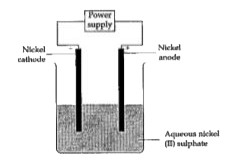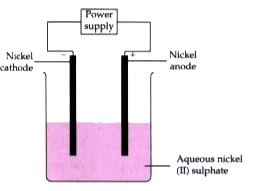A solution of copper (II) sulphate is electrolysed between copper electrodes by a current of 10.0 amperes passing for one hour. What changes occur at the electrodes and in the solution?
To solve the problem of what changes occur at the electrodes and in the solution during the electrolysis of copper (II) sulfate between copper electrodes, we can follow these steps:
Step 1: Understand the Electrolysis Process
Electrolysis involves the decomposition of a compound in solution using an electric current. In this case, we are using copper (II) sulfate (CuSO₄) in an aqueous solution with copper electrodes.
Step 2: Convert Time to Seconds
The current is given as 10.0 amperes and it is passed for 1 hour. We need to convert the time into seconds for calculations:
1 hour=60 minutes×60 seconds/minute=3600 seconds
Step 3: Identify the Reactions at the Electrodes
- At the Cathode (Reduction occurs): Copper ions (Cu²⁺) in the solution gain electrons and are reduced to copper metal (Cu).
Cu2++2e−→Cu (s)
- At the Anode (Oxidation occurs): Copper from the anode is oxidized to copper ions (Cu²⁺) and enters the solution.
Cu (s)→Cu2++2e−
Step 4: Calculate the Amount of Copper Deposited
Using Faraday's laws of electrolysis, we can calculate the mass of copper deposited at the cathode. The formula is:
W=I×t96500×Equivalent weight
Where:
- W = mass of copper deposited
- I = current (10.0 A)
- t = time (3600 s)
- 96500 = Faraday's constant (C/mol)
- Equivalent weight of copper = MolarmassValency=63.5 g/mol2=31.75 g/equiv
Substituting the values:
W=10.0A×3600s96500×31.75
Calculating W:
W=3600096500×31.75≈11.84 g
Step 5: Conclusion on Changes
- At the Cathode: 11.84 grams of copper is deposited.
- At the Anode: Copper is oxidized, and there is no net change in the concentration of the copper (II) sulfate solution because the amount of copper ions released into the solution equals the amount deposited at the cathode.
Summary of Changes
1. At the Cathode: Copper is deposited (11.84 g).
2. At the Anode: Copper is oxidized to Cu²⁺ ions.
3. In the Solution: No overall change in concentration of Cu²⁺ ions.
Electrolysis involves the decomposition of a compound in solution using an electric current. In this case, we are using copper (II) sulfate (CuSO₄) in an aqueous solution with copper electrodes.
The current is given as 10.0 amperes and it is passed for 1 hour. We need to convert the time into seconds for calculations:
1 hour=60 minutes×60 seconds/minute=3600 seconds
- At the Cathode (Reduction occurs): Copper ions (Cu²⁺) in the solution gain electrons and are reduced to copper metal (Cu).
Cu2++2e−→Cu (s)
- At the Anode (Oxidation occurs): Copper from the anode is oxidized to copper ions (Cu²⁺) and enters the solution.
Cu (s)→Cu2++2e−
Using Faraday's laws of electrolysis, we can calculate the mass of copper deposited at the cathode. The formula is:
W=I×t96500×Equivalent weight
Where:
- W = mass of copper deposited
- I = current (10.0 A)
- t = time (3600 s)
- 96500 = Faraday's constant (C/mol)
- Equivalent weight of copper = MolarmassValency=63.5 g/mol2=31.75 g/equiv
W=10.0A×3600s96500×31.75
Calculating W:
W=3600096500×31.75≈11.84 g
- At the Cathode: 11.84 grams of copper is deposited.
- At the Anode: Copper is oxidized, and there is no net change in the concentration of the copper (II) sulfate solution because the amount of copper ions released into the solution equals the amount deposited at the cathode.
1. At the Cathode: Copper is deposited (11.84 g).
2. At the Anode: Copper is oxidized to Cu²⁺ ions.
3. In the Solution: No overall change in concentration of Cu²⁺ ions.
Topper's Solved these Questions
- BOOK - ALLENCHAPTER - ELECTROCHEMISTRYEXERCISE - COMPREHENSION TYPE18videos
ELECTROCHEMISTRY
- BOOK - ALLENCHAPTER - ELECTROCHEMISTRYEXERCISE - INTEGER TYPE18videos
ELECTROCHEMISTRY
- BOOK - ALLENCHAPTER - ELECTROCHEMISTRYEXERCISE - EXERCISE -05 [B]38videos
ELECTROCHEMISTRY
- BOOK - ALLENCHAPTER - CHEMISTRY AT A GLANCEEXERCISE - ORGANIC CHEMISTRY472videos
CHEMISTRY AT A GLANCE
- BOOK - ALLENCHAPTER - HYDROCARBONEXERCISE - MCQ15videos
HYDROCARBON
Similar Questions
When an aqeous solution of copper (II) sulphate is electrolysed between two copper electrodes , the blue colour ions are discharged and deposited as metallic copper at cathode . But the blue colour of the solution does not fade . Explain.
View SolutionA solution of copper sulphate is electrolysed using a current strength of 3 amp to deposite 60 grams of copper. What is the time taken for the electrolysis?
View Solution
Knowledge Check
- Question 1 - Select One
An aqueous solution of nickel (II) sulphate was electrolysed using nickel electrodes. Observe the diagram and answer the questions that follow :

Which equation for the reaction at the anode is correct?ANi→Ni2++2e−BNi+2e−→Ni2+CNi2+→Ni+2e−DNi2++2e−→Ni
An aqueous solution of nickel (II) sulphate was electrolyzed using nickel electrodes. Observe the diagram and answer the questions that follow

Name the cation that remains as a spectator ion in the solution.View SolutionCopper sulphate solution (250ML) was electrolyzed using a platinum anode and a copper cathode. A constant current of 2mA was passed for 16min. It was found that after electrolysis the absorbance of the solution was reducted to 50% of its original value . Calculate the concentration of copper sulphate in the solution to begin with.
View SolutionA solution of sodium sulphate in water is electrolysed using inert electrodes, The products at the cathode and anode are respectively.
View SolutionThe aqueous solution of copper(II) sulphate is slowly hydrolysed forming basic copper sulphate whose chemical composition is:
View Solution108 g solution of AgNO3 is electrolysed using Pt electrodes by passing a charge of 0.1 F. The mass of resultant solution left is :
View Solution(a) The e.m.f. of the following cell at 298 K is 0.1745 V
Fe(s)/Fe2+(0.1M)//H+(xM)/H2(g)(1 bar)/Pt(s)
Given : E0Fe2+/Fe=−0.44V
Calculate the H+ ions concentration of the solution at the electrode where hydrogen is being produced.
(b) Aqueous solution of copper sulphate and silver nitrate are electrolysed by 1 ampere current for 10 minutes in separate electrolytic cells. Will the mass of copper and silver deposited on the cathode be same or different? Explain your answer.View Solution1 litre aqueous solution of NaCl was electrolysed bètweern Pt electrodes passing a direct current of 12.87 A for 100s with a current efficiency of 75%. Calculate pH of the solution after electrolysis assuming no change in volume of solution.
View Solution

